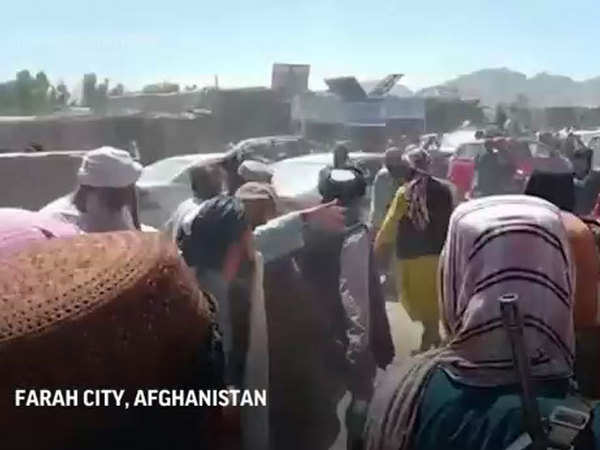By Dipanjan Roy ChaudhuryThe
Taliban today took the city of Ghazni, a mere 150 kms from the Afghan capital of Kabul, according to official sources in
Afghanistan. With this, the spectre of fanatical militamen taking over the country again, taking it back to the dark days of Taliban rule, has become very real.
The Islamists now control 65% of the country. They have already taken or are likely about to take 11 provincial capitals, an EU official said.

The speed of the Taliban advance and feeble resistance from the Afghan Army has surprised defence and security analysts around the world. Even
Pakistan is reportedly surprised by Taliban's rapid advance.
In just over a couple of months since the
US withdrawal commenced, the Taliban have doubled the number of districts under their control. But what is even more spectacular is the fact that they have made significant inroads in areas which were traditionally not their strongholds and from where the maximum resistance to them came. These areas include a number of provinces in the north and west of Afghanistan which have never really welcomed the Taliban.
The manner in which they have surrounded populations and key power centres suggests that they are confident that they can capture more towns and cities without too much trouble or fighting.
Clearly, the way the battlefield is shaping up, it seems to be just a matter of time – or maybe a couple of months – before the Taliban walk in triumphant into Kabul. Chances are that the Taliban would like to be ensconced in Kabul on or before September 11 or perhaps even October 7, when the US-led invasion started, but certainly before November 13 when Kabul fell to the erstwhile Northern Alliance. The question, therefore, is not so much about how and when the Taliban will establish their sway over a substantial part of, if not the entire, Afghanistan; the real issue is what happens the day after the Taliban take over Kabul and much of Afghanistan.
There are broadly three dimensions to what will happen once the Islamic Emirate re-establishes itself. The first is the sort of governance model they impose and the repercussions, both domestic as well as international, of this model; the second dimension is the security situation inside Afghanistan and whether or not there will be resistance, and foreign interference and involvement on the side of the resistance, and how this will play out both domestically and internationally; and the third dimension is what will provide sanctuary to jihadists from around the world, whether it will become “Terror Central”, whether it will support jihadist and Islamist causes in other countries, and whether it will export its brand of radical Islam to other countries in the region and beyond.
Governance Model
Unless someone has been completely taken in by the ambiguously worded “changed” worldview of the Taliban, it is very clear that the Taliban are more medieval than moderate in not just their governance but also their social policy. There could be some very minor tweaks from the Taliban 1.0 model of the 1990s but by and large it remains unreconstructed. This means that there will be strict interpretation of Sharia, not just in the running of the Emirate but also on social and religious issues. The Taliban will follow hard-line, antediluvian policies on women and religious minorities. The Shias and other Islamic sects, if not killed, will be persecuted. Their rule will be very arbitrary and power will be exercised by both the Mullahs and the military commanders – an abiding feature of Pashtun society in which the Maliks the Mullahs tend to share power.
There is a very high likelihood of the Taliban massacring their opponents and those whom they consider as having sided with the ‘invaders’. The fear of these reprisal killings and the stifling controls the Taliban will impose is likely to result in yet another exodus out of Afghanistan. While some Afghans will be able to go to Europe and North America, perhaps even the Middle-east, the bulk of the refugees will head to either Pakistan or Iran or even up north into the Central Asia states. This will once again create a bid refugee crisis and bring with it security and economic challenges for the neighboring countries. Inside Afghanistan, the fact that the Taliban have limited administrative experience means that they have little knowledge of how to run a modern administration. Their ability to run the ‘Emirate’ will also be constrained by the resource crunch that they will confront.
Simply put, Afghanistan is not a financially viable state and depends on foreign assistance to run the government. This assistance is likely to run out if the Taliban grab power. Unlike the 1990s when Pakistan was still in a position to provide some cushion to the Taliban government, it is now struggling. It is not clear if the Saudis or
UAE will fund the Emirate, especially if the Emirate pretends to be run by an Emir-ul-Momineen. China is not exactly known for being very generous with its money but could fund the
Taliban Emirate to small extent. But Chinese assistance will also depend on Taliban attitude towards China’s treatment of Muslims and its relationship with Uighur Islamists struggling against China. With the economy going into a tailspin, many of the educated and qualified Afghans will want to get out, creating a big void in terms of people who can run critical infrastructure. It is of course possible that these Afghans will be replaced by qualified Jihadists from other parts of the world who will make a beeline for the Emirate because they want to live under an undiluted Islamic Emirate – basically the sort of thing that happened with the Islamic State in the Levant and Iraq. But the implication of the Taliban Emirate becoming a magnet for Jihadists from around the world is that they will use it as a base for exporting this ideology in their own countries.
Security Situation
While it appears that the Taliban are well poised to re-establish their Emirate, what is not clear is if there will be any resistance to them and of what level. There are broadly three or four possibilities. The first is that after the initial setbacks, the ANA will regroup (at least the elements of ANA who are not ready to reconcile to the Taliban and resist Taliban advance; the second possibility is that there will be is no ANA as a coherent force, but individual war loads and communities from forces to resist the Taliban in their areas; the third possibility is that there are a few holdouts across the country where there are pockets of resistance; the fourth is that there is resistance from groups that operate from outside Afghanistan’s borders – in Central Asia or Iran.
There is a good chance that elements that resist the Taliban will get assistance from external actors. This will mean that Afghanistan will become a playground for external powers trying to counter each other and the Taliban. The response of the Taliban remains to be seen. At one level, such foreign interference will incentivize them to pay back these countries by giving refuge to their dissidents and directing attacks into these countries. In the event, the arc of destabilization of the region will expand. At another level, the longer the war inside Afghanistan continues, the more instability will radiate in the region. But the question is also whether the resistance will be able to halt the momentum propelling the Taliban? Snuffing out resistance in isolated pockets or from hastily assembled militias is unlikely to be very difficult for the Taliban. Also, their supporters in Pakistan will also double down in their backing for the Taliban because many of Pakistan’s grand plans depend on the Taliban managing to establish their control and suppress all resistance to their rule.
Foreign and Security Policy
The final dimension pertains to the foreign and security policy of the Taliban. Will the Taliban emerge as an independent entity or will it remain a hostage to the strategic grand designs of Pakistan? If the Emirate snaps the strings that tie it to Pakistan, how will Pakistan react? Will it use its proxies like Haqqani Network and commanders
loyal to Pakistan to lean on the Emirate? Will Pakistan’s overbearing attitude lead to dissensions and divisions within the Taliban ranks between the pro-Pakistan lobby and the lobby which wants Afghanistan to forge an independent foreign policy not tied to Pakistan’s interests? Will this division lead to internecine conflict or will it be a normal sort of policy difference which will find some equilibrium within the Emirate? The Pakistan angle aside, how will Taliban deal with rest of the world? Will they sponsor and provide sanctuary to Islamists from around the world? Both Taliban’s links as well as Pashtun traditions demand they cannot refuse refuge to anyone seeking it. This will then add to the disquiet in other countries whose dissidents, rebels and terror groups find refuge in Afghanistan, and they will then be tempted to fund and equip resistance against the Emirate, more so if it is discovered that Taliban assurance that they won’t let anyone use Afghan territory against any other country remains only on paper.
The India Factor
For India, the primary concern in Afghanistan is security related. Instability in Afghanistan tends to naturally destabilize the region and its impact will inevitably radiate into India. One immediate concern will be about Afghanistan becoming a safe haven for anti-India Jihadist groups like the Jaish-e-Mohammad and the Lashkar-e-Toiba (LeT) in Kashmir and other Indian terrorist groups. Another concern will be of Indian citizens wanting to go and live in the ‘pristine’ Islamic Emirate. There have been instances in the past of radicalized Indian Muslims going to Afghanistan to live under the rule of the Islamic State Khorasan Province.
Some of these radicals might decide to now join the ranks of the Taliban and then spread that ideology and even initiate terror attacks inside India after receiving training in Afghanistan. Apart from Kashmiri and Indian terrorists, Afghanistan becoming a hub for international Jihadists, some of whom see India as a Dar-ul-Harb (Land of War) is another serious concern. Pakistan of course will want to use Afghan territory against Indian interests, both inside Afghanistan as well as India.
India should be under no illusion about the Taliban. Nor should overlook the Taliban or show unseemly haste and keenness to engage the Taliban. If not immediately, then eventually the Taliban will seek out India, to counter-balance Pakistan, but also for India’s own equities and assistance that have been provided to Afghanistan over the last 20 years. Ideally, India should play it by the ear, wait for the opportunity and to the extent possible, even try and create the opportunity by driving a wedge between the Taliban and Pakistan. At the same time, India should not dump its friends in Afghanistan.
To the maximum extent possible, India should remain engaged with the liberal leadership of Afghanistan, including regional strongmen from among the Pashtuns, Uzbeks,
Tajiks and Hazaras; provide support to sustain the regime in Kabul to the extent possible as well as long-term visas to ease the path of any of India’s friends who seek to come to India to escape the Taliban.
India also needs to become very active in engaging Iran, Russia and some of the Central Asian states that are concerned about the Taliban coming to power and which might become players in propping up any resistance against the Taliban. But it is imperative that India not place any faith in these prospective partners, not until they demonstrate their commitment against the Taliban. Afghanistan is the land of treachery, and this treachery is not limited to only what happens inside Afghanistan but also among anyone who deals with Afghanistan.





